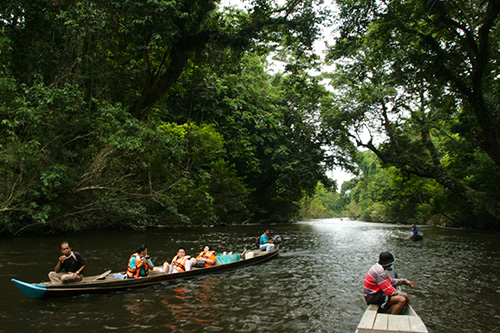Taman Negara is the crown jewel of tropical rainforests in Asia. Reputed as the oldest of its kind in the world (130 million years old), it has evolved amid natural disasters and been generally unmolested by human civilisation — creating an epicentre for the most diverse distribution of flora and fauna on the planet. There’s 150 mammal species ranging from tiny rodents to magnificent Indian elephants, 479 species of birds and a host of native animals unique to Malaysia.
Established in 1939 under British rule, Taman Negara is a whopping 4343 square kilometres spanning three states. The expanse is covered in a criss-cross of meandering rivers, rapids and waterfalls; a mountain range and lush valleys with 30 to 40 metre canopies that obscure the sunlight.

Banyan buttressed roots in Taman Negara
As the forest reserve is so big — it would literally take years or even decades to fully explore with scientists discovering new species all the time — we have condensed the itinerary to focus on the
must-see sights and must-do activities for first time visitors.
Jungle Trekking
You can’t go to Taman Negara and not trek into the depths of the jungle. During the day you can see rare jungle flowers and take amazing photos at the base of 40m tall trees with gargantuan banyan buttressed roots. Also keep your eyes peeled for sightings of the gorgeous pitcher plant species. There are various trails to choose from, all for different levels of ability. For the more adventurous, check out the 53km long distance trail from Kuala Tahan to Gunung Tahan. It takes seven days and six nights and is one of the most challenging trails and seldom explored in the park.
Night Jungle Walk
The fun begins when the sun sets. Most fauna here are generally crepuscular (active between dusk and dawn) or nocturnal so the best time to catch a glimpse of native wild animals is after dark. Some trails run along rivers that are known to be feeding grounds for seladang (Malaysian gaurs), deers, monkeys and wild boars. If you are really lucky, you may spot a well-camouflaged black panther stalking in the trees or a herd of elephants dipping their trunks into the stream. If you fail to spot any wildlife, head to the salt licks and the animal observatories at Tahan Hide or Kumbang Hide, where there is ample deers, wild boars and Malayan tapir to see.

The Canopy Walkway at Taman Negara is a must!
Canopy Walkway
Taman Negara’s canopy walkway is arguably one of the longest in the world at 530m and is 40m above the ground. The dense canopy is home to a myriad of bird species and arboreal animals that have formed complex ecosystems at such altitude. It is also common to see certain trees towering above the walkway and these giants are estimated to by thousands of years old. Interestingly, the walkway was initially built for research purposes, but is now the most common attraction at the park and can be reached by boat or trekking, just 1.2km from Park HQ.
Orang Asli Villages
Although Taman Negara is relatively pristine and untouched, the tribal people have coexisted here for thousands of years. The Batek and Semokberi aborigines have beautiful rustic settlements where they use blowpipes and spears to hunt game. They are very approachable and friendly people but are extremely superstitious as well so visitors are advised to respect their traditions and cultures. If you want to take a photo of them, make sure you ask for permission first.

Batek people have been living in Taman Negara for centuries — nationalgeographic.com
Adventure Exploration
If you are an adrenaline junkie, jump on a wooden boat that will rip through the seven river rapids of Sungai Tembeling. The rapids are highly rated and you will definitely be drenched by the end of the journey. Alternatively, you can cruise upstream to Late Berkoh, one of the most photographed areas of Taman Negara. There’s also finishing adventures for the serious angler, with popular spots including Kuala Perkai, Rincing, Rawa and Lata Said. The best fishing months are during drier months in February to September of the year.

A journey to Late Berkoh will be one to remember — www.tamannegara.asia
Gunung Tahan
Gunung Tahan is the tallest peak in Peninsula Malaysia at 2,187m and takes four days to reach the top with camping needed each night. Depending on your fitness levels, you can traverse the old trail which usually take six to seven days of trekking through valleys.hilly areas and rivers and is 32km longer. You will need to register and pay a small fee for access and be sure to have water proof flash lights with back up batteries as well as a custom built first aid kit. To learn more about Gunung Tahan hiking, click here: http://www.tamannegara.asia/packages/other-packages/gunung-tahan-expedition/
For more information about your ultimate Taman Negara experience go to: http://www.tamannegara.asia/











